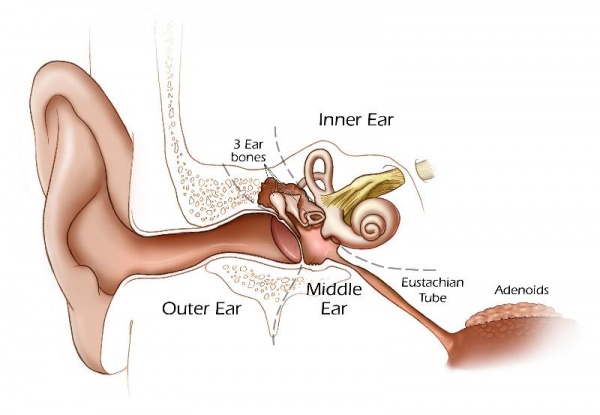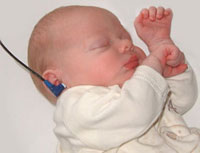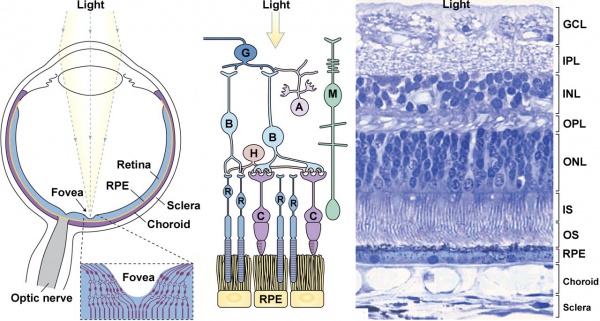K12 - Communication: Difference between revisions
mNo edit summary |
mNo edit summary |
||
| Line 45: | Line 45: | ||
===External Ear Growth before Birth=== | ===External Ear Growth before Birth=== | ||
'''The position and shape of the external ear can tell you about how the head has grown before birth!''' | |||
This can also be used as an indicator for some abnormalities in development (for example, fetal alcohol syndrome). | |||
{| | {| | ||
Revision as of 18:10, 22 April 2013
Introduction
Biological communication occurs at many levels, from one cell communication with its neighbour in a tissue (paracrine), to signals released into the blood from one cell to signal to another cell or tissue (endocrine or hormone signaling). The signalling that occurs in the brain, spinal cord and other nervous tissues involves electrical (action potentials) signaling.
This page will introduce development of signaling in our special sensory nervous systems: the eyes for vision and the ears for hearing. Both systems convert signals in one medium (light or sound) into an electrical signal that our brain can understand.
Sound - Hearing
This cartoon shows the adult "ear" with the 3 main divisions (outer, middle, inner).
Outer Ear
|
Middle Ear
|
Inner Ear
|
Hearing Before Birth
Before birth the baby cannot "hear" like we do!
Instead during the third trimester vibrations of the mother's body, vibrate the fluid surrounding the baby, that then vibrate the baby's head that stimulate the hearing pathway. This can sometimes result in a "startle-like" response.
- The middle ear is filled with fluid instead of air so the middle ear bones (ossicles) cannot move freely.
- The pathway to the brain, and the part of the brain that interprets sounds, have not yet full developed.
| Why can't the baby hear? |
|---|
External Ear Growth before Birth
The position and shape of the external ear can tell you about how the head has grown before birth!
This can also be used as an indicator for some abnormalities in development (for example, fetal alcohol syndrome).
| Month 3 - Fetus | Month 4 - Fetus | Month 5 - Fetus |
|---|---|---|

|

|

|
Testing a Baby's Hearing
If a baby cannot hear you talk they cannot easily learn to speak!
Much of your first learning comes from being able to copy sounds that you hear. The parents or doctors would only know that a baby could not hear if they were not developing speech correctly or meeting other developmental milestones.
- In the past - the tests were very simple, like turning their head to a bell or sound. They could also not be easily carried out on newborn infants.
- Today - the tests are computer-based, requiring no infant response and can be easily carried out on newborn infants.
| About Newborn Hearing Tests |
|---|
Whats an Automated Auditory Brainstem Response? (AABR) uses a stimulus which is delivered through earphones and detected by scalp electrodes. The test takes between 8 to 20 minutes and has a sensitivity 96-99%. The basis of a neonatal hearing test that uses a trigger stimulus delivered through earphones and subsequent brain electrical activity then detected by scalp electrodes. Then by computer analysis, averaging all the electrical activity following the trigger, peaks emerge reflecting signal passage activity through brain stem nuclei in the hearing central neural pathway. The infant test takes between 8 to 20 minutes, has a sensitivity 96-99%, and unlike other childhood auditory testing does not require a subject response. An alternative and simple test (pass/refer) used at a later stage is otoacoustic emission testing. |
Light - Vision
This cartoon[1] shows the eyeball (left), a cartoon of the retinal cell organisation (middle) and an actual slice of the human retina.
The Eye
|
Retinal Cell Organization
These are the names of the cells and neurones required to convert light into electrical signals. (detect, process and carry)
Notice that light has to pass through all the other cell layers to the detection cell layer. |
Glossary Links
- Glossary: A | B | C | D | E | F | G | H | I | J | K | L | M | N | O | P | Q | R | S | T | U | V | W | X | Y | Z | Numbers | Symbols | Term Link
Cite this page: Hill, M.A. (2024, April 16) Embryology K12 - Communication. Retrieved from https://embryology.med.unsw.edu.au/embryology/index.php/K12_-_Communication
- © Dr Mark Hill 2024, UNSW Embryology ISBN: 978 0 7334 2609 4 - UNSW CRICOS Provider Code No. 00098G
- ↑ <pubmed>20855501</pubmed>| PMC3101587 | JCB



